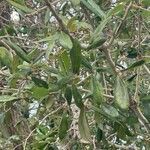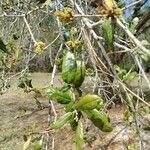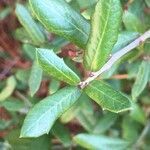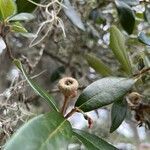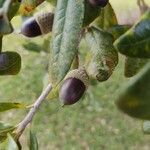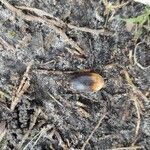Trees, sometimes shrubs , subevergreen, trees to 35 m, shrubs sometimes rhizomatous. Bark dark brown or black, scaly. Twigs yellowish to light gray, 1-3 mm diam., minutely puberulent or stellate-pubescent, glabrate in 2d year. Buds reddish or dark brown, subglobose or ovate, 1-2 mm; scale margins glabrous or puberulent. Leaves: petiole 1-10(-20) mm. Leaf blade obovate to oblanceolate, sometimes orbiculate or lance-ovate, ± planar, (10-)35-90(-150) × (15-)20-40(-85) mm, base cuneate to rounded, rarely truncate or cordate, margins minutely revolute or flat, entire or irregularly 1-3-toothed on each side, teeth mucronate, secondary veins obscure, 6-9(-12) on each side, apex obtuse-rounded or acute; surfaces abaxially whitish or glaucous, densely covered with minute, appressed, fused-stellate hairs, light green and glabrate in shade leaves, adaxially dark or light green, glossy, glabrous or with minute, scattered, stellate hairs. Acorns 1-3, on peduncle (3-)10-20 mm; cup hemispheric or deeply goblet-shaped, 8-15 mm deep × 8-15 mm wide, base often constricted; scales whitish or grayish, proximally thickened, keeled, tomentulose, tips reddish, acute-attenuate, glabrous or puberulent; nut dark brown, barrel-shaped, ovoid, or obcylindric, 15-20(-25) × 8-15 mm, apex rounded or blunt, glabrous. Cotyledons connate.
More
Large, evergreen tree (to 20 m), with widely spreading branches that often support Tillandsia, or smaller in difficult habitats and only shrubby (such plants often called var. minima Sarg.); bark furrowed and cross-checked into small plates; lvs firm, flat, narrowly elliptic to oblong, mostly 4–8 × 1–2 cm, blunt, entire, cuneate to obtuse at the base, glabrous above, closely and tightly cinereous with minute stellate hairs beneath (these scarcely distinguishable at 20×, sometimes even at 30x), less obviously veiny than no. 12 [Quercus geminata Small]; acorns solitary or paired, 1.5–2.5 cm, the cup turbinate, 8–15 mm, its scales acute, closely appressed. Dry or moist soil on the coastal plain; se. Va. to Fla., Tex., and ne. Mex.
A tree which keeps its leaves through the year. They loose some leaves in colder regions. It grows to 12-15 m tall. It spread out widely. The branches are large and spread widely almost reaching the ground. The leaves are narrow and oval. They are 5-13 cm long. The edge is smooth. They are dark green and shiny above and whitish underneath. The acorns are narrowly oval and 2.5 cm long. They are enclosed for almost half their length in reddish-brown cups. The nuts are sweet and edible.
Sandy dry to wet soils, occasionally in heavy clay, growing especially by the coast in dry sandy woods, moist rich woods or wet woods; at elevations up to 100 metres.
More
It is a temperate plant. It can grow on most soils. It can tolerate frost. It can resist salt spray. It suits hardiness zones 7-11.
